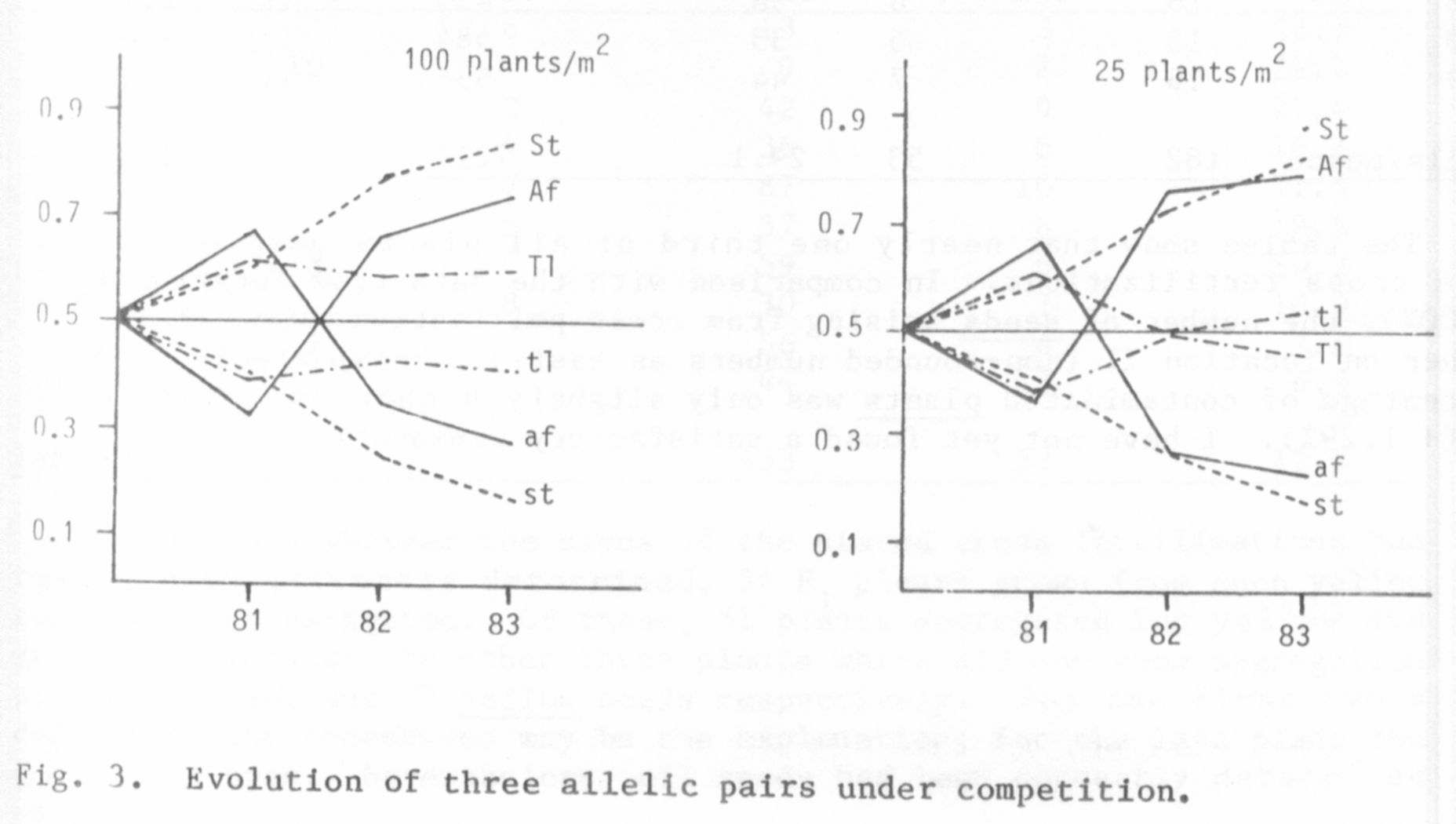36 PNL Volume 16 1984
RESEARCH REPORTS


Fig. 1. Contribution of each genotype to the total seed yield of the
mixture at two planting densities.
|
|
||||||
|
PNL Volume 16 1984
|
RESEARCH REPORTS
|
35
|
||||
|
|
||||||
|
COMPETITIVE EFFECTS AMONG ISOGENIC LINES OF PEAS
|
||||||
|
|
||||||
|
Leone, A.
|
Centro di Studio per il Miglioramento
Genetico degli Ortaggi
Consiglio Nazionale delle Richerche
Portici, Italy
|
|||||
|
|
||||||
|
|
In order to study the effect of single genes or of the interaction
of few genes on the competitive ability, eight isogenic lines of peas,
provided by G. A. Marx, were utilized. They were a complete set of all
combinations of the three genes, af (afila), st (reduced stipules) and
tl (acacia), affecting the foliage morphology.
In 1980 a seed mixture of an equal number of seed from each
genotype was sown at two different planting densities (100 plants/m2 and
25 plants/m2 ); in the two following years a sample of the bulk harvested
seed was sown. Data concerning 1981, 1982, and 1983 are reported here.
The proportion of both the conventional (+++) and the "acacia"
(+ + tl) types increased each year, reaching about 60% in the last year,
whereas the other six genotypes contributed very little to the total
yield of the mixtures (Fig. 1). The conventional and acacia plants had
the highest seed yield per plant (Table 1) and consequently they were
the majority of the plants in the mixture, as shown by Glover (1). In
1982 the eight lines were also grown in pure stand and the conventional
and the acacia types showed the highest yield per plot (2); a positive
relationship between agronomic value and competitive ability is sug-
gested, as found by other authors in different species.
The eight genotypes were gathered on the basis of the presence or
absence of one, two, or three genes, in order to study their effects on
competitive ability.
The af genotypes and the st genotypes showed lower productivity
than their corresponding dominant genotypes. In contrast, the acacia
types had the same productivity as their corresponding dominant
genotypes (Fig. 2). Therefore, the alleles af and st disappeared
quickly in the mixture in comparison with their corresponding dominant
alleles, whereas the tl allele was in equilibrium with its dominant
allele (Fig. 3). This behavior presumably is related to the increased
foliage area of the acacia types.
This experiment is being continued; in 1981, 1982 and 1983 three
new similar experiments were begun.
|
|
||||
|
1. Glover, T. J. 1980. PNL 12:12-14.
1. Gritton, E. T. 1972. PNL 4:11-12.
Contribution No. 5 from Centrol di Studio per il Miglioramento
Genetico degli Ortaggi, CNR - Portici (Napoli).
|
||||||
|
|
||||||
|
|
|||
|
36 PNL Volume 16 1984
|
RESEARCH REPORTS
|
||
|
|
|||
 |
|||
|
|
|||
 |
|||
|
|
|||
|
Fig. 1. Contribution of each genotype to the total seed yield of the
mixture at two planting densities.
|
|||
|
|
|||
|
|
||||
|
PNL Volume 16 1984
|
RESEARCH REPORTS
|
37
|
||
|
|
||||
 |
||||
|
|
||||
 |
||||
|
|
||||